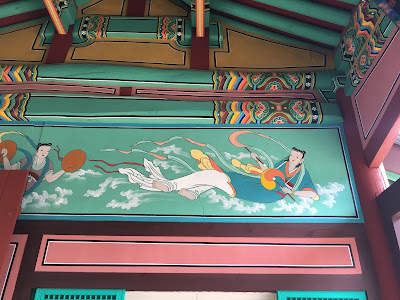The following morning, (once we managed to squeeze ourselves into the car - yes, about all Korean parking stalls leave about 8 inches between parked cars) we drove east toward Gayasan Mountain to visit Haeinsa Temple and to hike to Sangwangbong Peak. Colorful apartments lined the road out of Daegu. The fact that it was a rainy day did not dampen our spirits, although it did cloud our views. Thankfully, Bob had a couple of light ponchos for us to wear as the rain began to fall. We arrived at Haeinsa Temple, which is a sacred site for Buddhists. It is here that the Triptaka Koreana is housed; the largest collection of Buddhist scriptures, which are engraved on over 80,000 woodblocks that were carved between 1237 and 1248. It is interesting to note that the swastika symbol holds great importance in the Buddhist tradition and thus, this symbol can be found on almost all the Buddhist sites including the temples. Buddhist Swastika is viewed as a sign of infinity, affluence, abundance and long life. The swastika symbol was adopted as a symbol of the Nazi Party of Germany, when Adolf Hitler came to power in the 1930s.
Leaving the temple grounds, we began a fairly easy hike which followed a stream through a beautifully wooded valley. But before long, the climb became rocky and steep. As usual, our Korean trails turned into a much more difficult ascent than anticipated. We could see the granite walls of Sangwangbong Peak through the rain and fog. But sadly, due to the dense cloud cover, we were not rewarded with the spectacular views promised at the end of our climb.
The long trail back down the mountain became a daunting task when my left knee seemed to freeze stiff and not allow me to bend my leg. It was a very painful and slow return hike . . . threatening to be one of my last! I think the combination of rain and stress caused my rheumatoid arthritis to flair and made for a rather miserable ending to an otherwise delightful trip to Daegu.



















































No comments:
Post a Comment